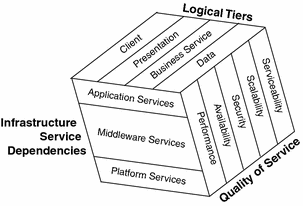About Logical Architectures
A logical architecture identifies the software components needed to implement a solution, showing the interrelationships among the components. The logical architecture and the quality of service requirements determined during the technical requirements phase form a deployment scenario. The deployment scenario is the basis for designing the deployment architecture, which occurs in the next phase, deployment design.
When developing a logical architecture you need to identify not only the components that provide services to users, but also other components that provide necessary middleware and platform services. Infrastructure service dependencies and logical tiers provide two complementary ways of performing this analysis.
Infrastructure service dependencies and logical tiers are two of the three dimensions of the solution architecture upon which Sun JavaTM Enterprise System is based. The three dimensions are listed below and are also represented in About Logical Architectures.
-
Infrastructure service dependencies. Interacting software components that provide enterprise services. The software components require an underlying set of infrastructure services that allows the distributed components to communicate with each other and to interoperate.
-
Logical tiers. A logical organization of software components into tiers that represent the logical and physical independence of software components, based on the nature of the services they provide.
-
Quality of service. System service qualities, such as performance, availability, scalability, and others that represent particular aspects of a software solution’s design and operation.

Note –
For more information on Java Enterprise System architecture concepts, refer to the “Java Enterprise System Architecture” chapter in the Sun Java Enterprise System 5 Technical Overview.
A logical architecture depicts infrastructure service levels by showing the necessary components and their dependencies. A logical architecture also distributes the components among logical tiers that represent presentation, business, and data services that can be ultimately accessed by a client tier. Quality of service requirements are not modeled in the logical architecture but are paired with the logical architecture in a deployment scenario.
- © 2010, Oracle Corporation and/or its affiliates
